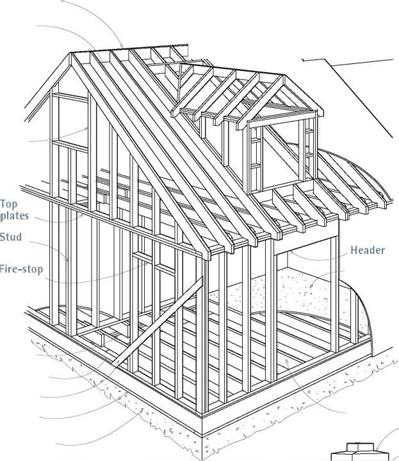TRAINING YOUR EYeI
The house shown on the facing page says much to a trained eye. Though nicely crafted, it’s showing its age. Despite the gleaming paint on the parts that can be easily reached, this house’s upper floors haven’t been painted in 20 years or 30 years, suggesting that the parts you can’t see probably weren’t maintained either. The fretwork above the porch is splintering, and the green shingle demi-roof over the living room window has worn through to the wood shingles underneath. Chances are this small roof isn’t flashed where it abuts the siding, so water may have gotten behind and soaked the framing.
Still, it’s a charmer, and it’s got great bones. Skilled carpenters were needed to frame such a complex roof, so there’s probably good workmanship throughout the house, which is old enough
that its 2x4s are probably full-size 2x4s. The walls are plumb; the roof ridge doesn’t sag; and despite its weathered appearance, the siding is largely intact.
However, if you’re house shopping, you’d want to get a bid for replacing the roof. Because the old shingles are tired, reroofing would likely be expensive, given the complexity of the roof structure and the likelihood of rot up there. Also, from the street, there’s no sign of gutters, so it would be crucial to inspect the joists, the mudsills, and the foundation itself.
Given the age of this house, the foundation probably isn’t reinforced with steel; and that, coupled with poor drainage, could mean big – ticket repairs—possibly a new foundation.
All in all, though, this old house would be an exciting prospect and is certainly worth a closer look.
gathering information
If you feel strongly about a house, start by asking the real estate agent or owner for a recent termite report and a disclosure statement, and read them closely. Most states require such disclosures from owners; if you are working with an agent, such statements are probably mandatory. Disclosure statements describe (1) things not originally built with a permit or not built according to code,
(2) code violations recently observed by an inspector, and (3) other conditions that the homeowner knows need fixing. Armed with this information, you can begin looking for unreported problems, which always exist.



![]()



![]()

![]()
![]()
![]()
![]()
![]()

Girder Sole plate Bracing Mudsill Foundation
These drawings contain most
of the building terms used in this chapter.
For additional terms, consult the Index, the Glossary, and pertinent chapters.
PRO TIP
If you see tar or roof cement slathered around chimney bases, plumbing stacks, roof valleys, and other roof joints, assume leaks may have occurred there, either because flashing failed or was never installed. Tar can be a functional, though ugly, shortterm fix, but be sure to replace old flashing when installing a new roof.
llll
Because of competitive bidding, buying a house can be nerve-wracking. But you can reduce some of the pressure by making your own preliminary inspection. This will enable you to delay paying for a professional inspector till you’re sure it’s a house you should seriously consider. You’ll be able to red-flag special concerns for the inspector. And, as a bonus, after conducting your own inspection, you’ll better understand the inspector’s report.
That said, it’s smart to hire an accredited house inspector to give you an impartial third – party opinion. Typically, house inspections take 2 hours or 3 hours and yield a detailed 20-page or 30-page field report. A house inspector can also recommend additional inspections, if warranted, by structural engineers, HVAC (heating, ventilation, and air-conditioning) specialists and the like.






Leave a reply